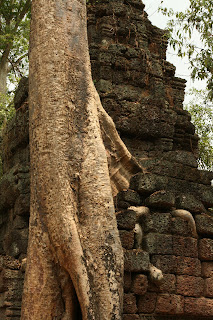We were out the door by 7 AM in an effort to get ahead of both the heat and the other Asian tourists (most notably the Chinese & Koreans, who are insistent on trampling areas where they shouldn't and posing in front of everything 1 or 2 people at a time). My question is, "What do they possibly do with all those photos anyway?"
We started at the South Gate of Angkor Thom ("the great city"), where we saw the angelic carving of the Jayavarman head, a motif found throughout the temple sites. ( Jayavarman is Sanskrit for Victorious Warrior, with "Jaya" being Sanskrit for "Victorious" or "Successful" and "Varman" being the word for "Warrior" or an expert in martial arts).
The bridge spanning the boat before the south entrance is lined with statues of gods and monsters in various states or repair and renovation. Supposedly, these gods & monsters are said to have been in competition to churn the proverbial sea of milk that would cause the creation of the world.
3 of the 4 faces of Buddha at the top of the gate entrance.
The Bayon Temple, the centerpiece of the larger Angkor Thom city and containing the most classic, carved faces, is the best loved Angkor temple. These faces are usually set in groups of 4 around a central prang or tower - each face indicating a compass direction.
A tower from the distance.
The classic faces up close.
We then did a quick drive-by of Baphuon, Terrace of the Elephant, Terrace of the Leper King, before ending the morning tour at Ta Prohm Temple.
Baphuon is a temple mount built in 1066 and an important Khmer capital. Bilateral efforts continue to try to piece the temple back together, but with so many jigsaw pieces it continues to be very slow going.
The Terrace of the Leper King, also built by Jayavarman, was supposedly the main viewing stage for the king and his entourage to watch elaborate shows.
The Elephant Terrace in the south end was also a viewing area - so named because of the elaborate carvings of the elephants who trunks made decorative columns.
Using an isolated jungle path to avoid the other tourists, Thai brought us to Ta Prohm, the dynamic jungle temple, composed of 39 towers connected by numerous galleries, with absolutely incredible Khmer Spoong trees and charay vines. This temple was also built by Jayavarman VII in 1186 and was heavily looted in recent years. But it continues to be very popular with tourists.
After a delicious home-hosted meal and quick freshening up, we departed the hotel for the primary reason for this extension - a chance to visit Angkor Wat Temple, whose 5 spires of the main temple are recognized the world over.
Angkor Wat, the pinnacle of Khmer architecture, was built under the reign of Suryavarman II during the 12th century. From base to tip, the highest tower is 669' high. The temple moat is 1-3/4 miles around and 295' wide. Angkor Wat is the only temple entered from the west and is the only monument that is a mausoleum. The main temple is dedicated to Vishnu.
The entrance is first gained by crossing the main moat causeway, restored in the 1960s by the French.
Naga sculpture in front of Angkor Wat
Monks crossing the entrance causeway.
Approach to the main temple.
Incredible statuary.
We finished the trip with a local wine tasting and some tasty snacks - peanuts, buffalo jerky, frog legs and snake - then headed back to the hotel, totally exhausted, for dinner and a much needed sleep before beginning the very long trip back home.



































No comments:
Post a Comment